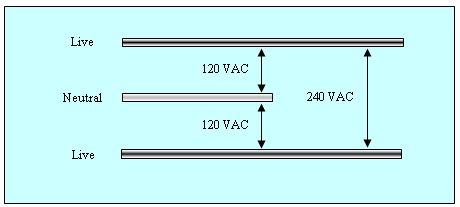The Electrical Service:
The electrical service coming into your home is a nominal 240 volts supplied as two 120 volt circuits 180 degrees out of phase. Hence when added together you get 240 volts, see Figure 3. The service is three wires, two 120 volt wires and one neutral wire.

Figure 3 - 120 - 240 VAC electrical service
These 3 wires carry on through the meter, through the main disconnect and to the distribution panel where each of the 120 volt wires is connected to a buss bar and the neutral wire is connected to a terminal block that is also connected to the grounding rod. Neutral and ground are a common connection in the distribution panel (load center).
Each of the required circuits in your home is connected through a circuit breaker (in older homes through a fuse) to the electrical outlet (receptacle), light fixture or device that requires the power. The circuit breaker or fuse, as the case may be, controls the maximum amount of amps that can be delivered to the required item or items on the circuit. The value of the circuit breaker, which can vary between 15 amps and 125 amps (main breakers are a different physical size) is a key to safety within the home. The circuit breaker or fuse provides protection in two different manners:
- A device, a motor, compressor, fan, heater, etc. is designed to draw a certain amount of power. Should something become defective within the device and it attempts to draw an excessive amount of power, the circuit breaker will trip or the fuse will blow, preventing any additional damage to the device or the individual operating the device.
- All circuits to electrical outlets (receptacles) and devices within the home are connected to the distribution panel (load center) by wires. The wire gauge chosen will only handle a certain amount of amperage. In the case of a 14 gauge copper wire, the maximum amperage load is 15. Twelve gauge copper wire will carry 20 amps and so on. If wires were not protected by a circuit breaker or fuse and the power demand increased passed their safe load, they would overheat and could easily cause a fire.
Additional information on wire sizes.
Many home fires are caused by overloaded circuits. One of the most common occurrences is that someone has increased the size of the breaker or fuse with total disregard for the size or gauge of the electrical wire.
Circuit breakers have also changed over the years. In areas, such as bathrooms where it is important to have Ground Fault Circuit Interruption GFCI
, it can be provided using a GFCI circuit breaker rather than GFCI electrical outlets (receptacles). The National Electrical Code (US) requires that bedrooms be protected with Arc Fault Circuit Interrupters AFCI
, which replace a standard circuit breaker in the load center (distribution panel).
The main distribution panel can also deliver power to sub-distribution panels. These panels make wiring a distant area more convenient. As an example, if you have a detached garage and workshop instead of running numerous electrical circuits to groups of receptacles and other devices it may be much more convenient to run one larger circuit from the main distribution panel to a sub-distribution panel in the garage. From the sub-distribution panel the power would be distributed at lower amperages throughout the garage and workshop. The sub-distribution panel contains a number of circuit breakers protecting the individual circuits.
Additional information on wiring a sub-panel
Circuit breakers do wear out and fail and when replacing a unit, in general you must buy the breaker that is made by the manufacturer of the distribution panel or a breaker that is identified as a specific replacement for the breaker in question.
Breakers, like fuses mount in the same position no matter what their rated amperage is. It is important therefore if replacing a circuit breaker to install the correct value of amperage protection and this is generally based on the size (gauge) of the wires connected to the breaker.
Installing Electrical Receptacles.
